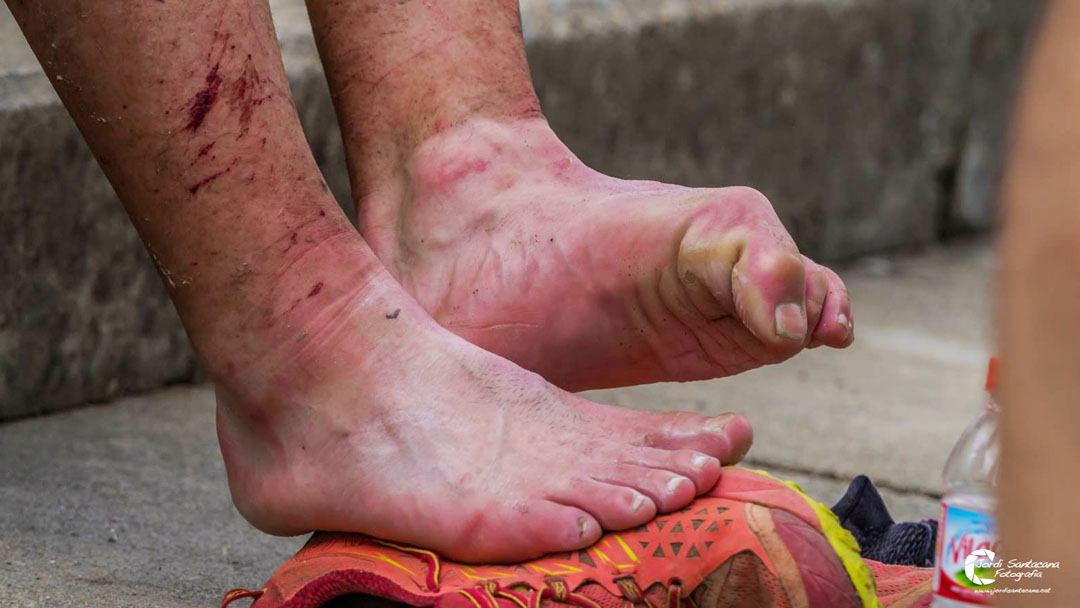Blisters can be a huge problem in adventure racing and other ultra endurance races. Just a few poorly placed blisters can lead to a DNF (did not finish) for an entire team. Blisters are so common and so annoying, and, mostly importantly, very painful. So, whatever your goal in adventure racing, the best thing you can do for your feet is to keep them in good condition and prevent blisters.
In this post, I give some helpful and practical tips on how to prevent getting blisters while adventure racing.
Why do I get blisters on my feet?
At the beginning of my racing career, I got blisters in almost every long adventure race. It was so frustrating and painful that eventually I decided to sit down and figure out once and for all what I could do to prevent blisters. I was surprised to learn that by taking just a few important steps, you can greatly reduce the number of blisters you get, and, in some cases, even prevent blisters completely.
Before I get to those steps, I first want to remind you that, like all things related to adventure racing, if you have low energy and you are dehydrated, everything else will go wrong too, including increasing your risk of acquiring blisters. This is because if you’re tired and dehydrated, you are more likely to become careless, which can cause problems to easily accumulate.
The main reasons that blisters form are:
- Shoes are the wrong size or wrong type.
- There is too much moisture on the foot, which can be due to sweaty feet or wet shoes and socks.
- Dirty shoes.
Wearing shoes that are too narrow or that taper can lead to blisters on your toes. Shoes that are too short will batter your toenails and shoes that are too big will lead to blisters on your heel. In a worst-case scenario, shoes that are both too wide and too large can make all of the skin on your soles loosen. Moreover, every seam or edge in your shoes—even the smallest ones—can cause soreness in your feet.
Read more: How to prevent stomach problems >>>
Five tips on how to prevent blisters in adventure racing
The origin of a blister will likely depend on your skin type—some people just blister more easily than others. However, anyone can help prevent blisters from forming by preparing and protecting your skin. Here are some tips to help prevent blisters before, during, and after a race.
1. Make sure your running shoe is the right size and type
There isn’t much you can do to prevent blisters if your trail running shoe isn’t perfect for you—both the size and the model have to be just right, and suitable for your purposes.
But how can you know if a given shoe type is the right one for you? In long adventure races, you need a trail running shoe for ultradistance. A shoe for ultradistance has soft edges and a wide toe area, both of which are important. In addition, your shoe size has to be slightly bigger than for a normal distance run because your feet swell a bit during longer races. That said, it’s important that you don’t choose a shoe that’s too big.
Before using a pair of trail running shoes in a long adventure race, you have to use them for several weeks, at least. Don’t ever wear a new pair of shoes to a race —that will cause you some serious problems for sure!
Sock made of cotton are also not a good option for running. Instead, choose breathable polyester or wool socks. Also, it’s a good idea to test your socks together with your shoes, just to make sure there isn’t too much friction. Consider trying two very thin socks instead of one thicker sock, as that can help reduce friction if the movement of your feet is causing soreness or blisters.
2. Lotion and lotion again
The more elastic the skin, the more durable it is. The ability of the skin to stretch is largely determined by your genes, but this function can also be supported by the liberal and frequent use of lotion. One way is to start applying lotion a few times a day 1 to 4 weeks before a race. Take a heavy lotion or cream and use it for warm feet after a bath. Good option is a heavy foot cream from pharmacy, like Neutrogena etc. This can especially help prevent blisters in your heels and sole and between your toes.
3. Don’t forget your pre-race routine!
Make sure you add in some blister prevention to your morning pre-race routine—you’ll thank yourself later! Some runners swear by talc, but I prefer a heavy anti-friction lotion or stick (like Compeed). The idea of the talc is to keep your feet dry. This works great on asphalt, but your feet typically get wet in adventure racing, so lotion is the better option. The main idea here is to decrease friction, so make sure you use a high-quality lotion or one specifically meant for preventing blisters. Use ample amounts of lotion, and make sure you spread it around heavily, even between your toes. After you’re finished with your application, go ahead and slip on your socks and shoes, confident that you’ve done your very best to prevent blisters.

4. Give your feet a rest at every transition
During a race is it very important to react right away if you feel a bit of soreness on your feet. A good routine is to take care of your feet in every transition area by doing the following every time:
- Take off your shoes and socks
- Clean your feet (baby wipes are great for this)
- Remain barefoot as long as possible
- Apply more lotion.
- Put on clean socks and different shoes, if possible
If you have to put on the same shoes as before (which is often the case), clean your shoes properly from the inside out.
Read more: How to prepare and measure energy for an adventure race >>>
5. Blisters happen, so be ready
Sometimes, no matter what you do, you still get blisters. Usually, when I get a blister, I apply a blister plaster, but if the blister is extremely sore or unusually large, I might decide to pop it. First, I clean the area around the blister, then I use a sterile needle to pop the blister, and finally, I apply the blister plaster. You are not allowed to take off blister plasters during races anymore, so it is important to make your plaster very resistant. I cover my plasters with sports tape very carefully. This is not the ideal situation, obviously, but it usually works quite well. Another thing to keep in mind is that after using tape, you can no longer apply lotion.
Extra tip
Give your feet a nice, long air bath after the race. Keep them clean and wear sandals. Stay hydrated, take warm showers, and take some easy walks to help your muscles, skin, and body recover.
Main photo of the post: Jordi Santacana, Raidaran adventure race.

